American Cuisine
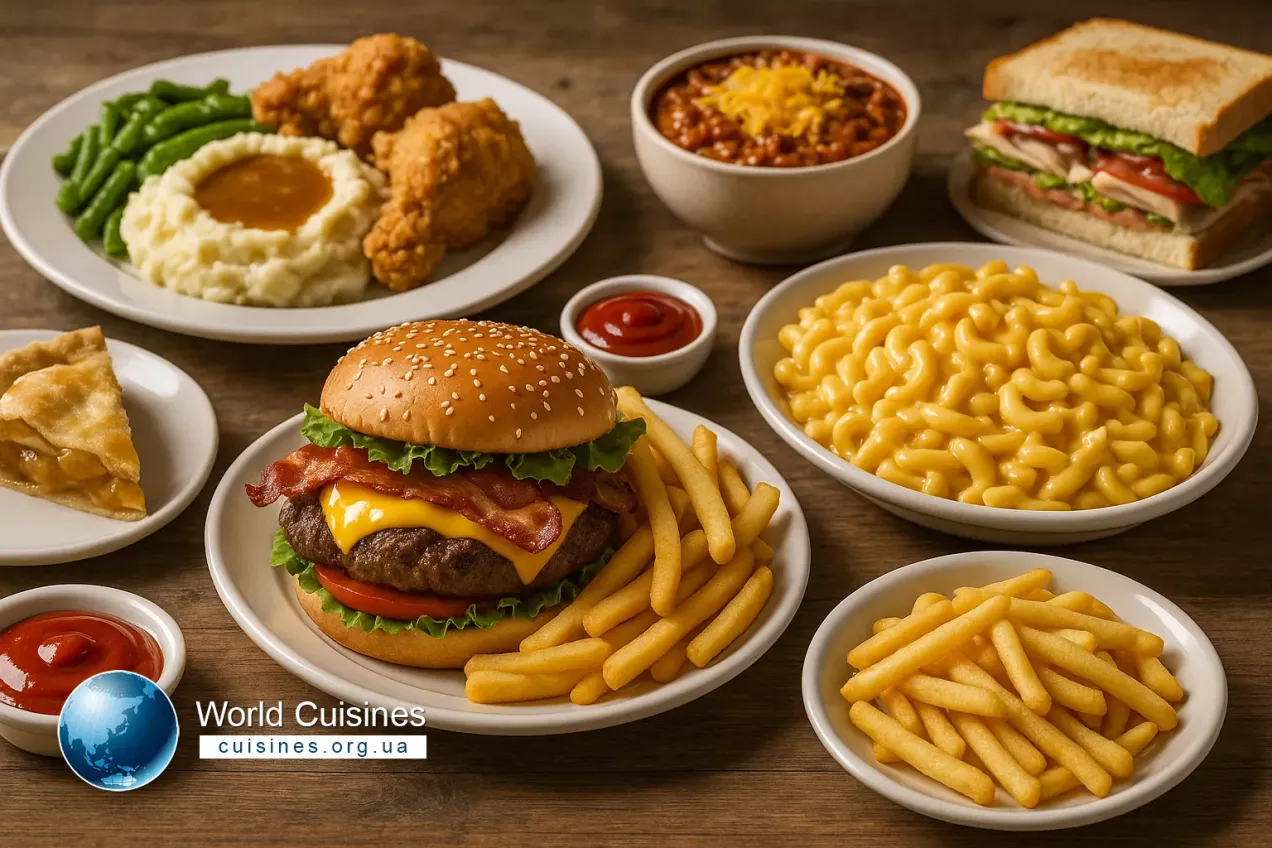
American cuisine is a dynamic culinary tradition that reflects the vast cultural, regional, and historical diversity of the United States. It has evolved through centuries of transformation – starting with the agricultural and hunting practices of Native American tribes, shaped by colonial encounters, and later enriched by the culinary traditions of immigrants from every corner of the globe. Rather than a single unified style, American cuisine is a mosaic of regional identities and cultural fusions. The sheer size of the country and its geographic variety – from the Pacific coast to the Atlantic, from the Great Plains to the Deep South – has given rise to distinct food traditions shaped by climate, migration, and local ingredients. Corn, beans, and squash, once staples of Indigenous agriculture, remain central in many modern dishes. The influences of British, German, African, Mexican, Italian, Chinese, and other cuisines can be tasted in everything from holiday roasts to weeknight tacos. What makes American cuisine unique is its openness to adaptation and invention. Classic dishes are constantly reinterpreted, and regional foodways evolve through both tradition and experimentation. Whether it’s the enduring legacy of soul food, the rise of plant-based cooking, or the global reach of American-style burgers and barbecue, this cuisine continues to grow while staying rooted in community and place.
Popular Questions About American Cuisine
Typical American cuisine is a blend of diverse culinary traditions, shaped by Native American practices, European settlers, and waves of immigration. It ranges from hearty Southern barbecue and Midwestern comfort foods to New England seafood dishes and modern fusion on the West Coast. Staples include beef, chicken, potatoes, corn, bread, and dairy, often served in generous portions and seasoned with bold flavors.
Classic American dinners usually feature a protein such as roast chicken, steak, or meatloaf, accompanied by sides like mashed potatoes, green beans, corn, or mac and cheese. Popular family-style meals include fried chicken with biscuits, Thanksgiving turkey with stuffing, and pot roast with vegetables. Regional traditions also influence dinner tables, such as gumbo in Louisiana or chili in Texas.
American cuisine refers to the collective food culture of the United States, representing a mixture of local ingredients, immigrant influences, and regional traditions. It has no single definition but instead encompasses a wide range of styles and dishes that reflect the nation’s cultural diversity, history, and innovation in cooking.
Among the most loved American foods are hamburgers, hot dogs, fried chicken, barbecue ribs, mac and cheese, apple pie, pancakes, clam chowder, buffalo wings, and cheesesteaks. These dishes have become iconic both within the U.S. and around the world, symbolizing the comfort and variety of American cooking.
Overview of American Cuisine
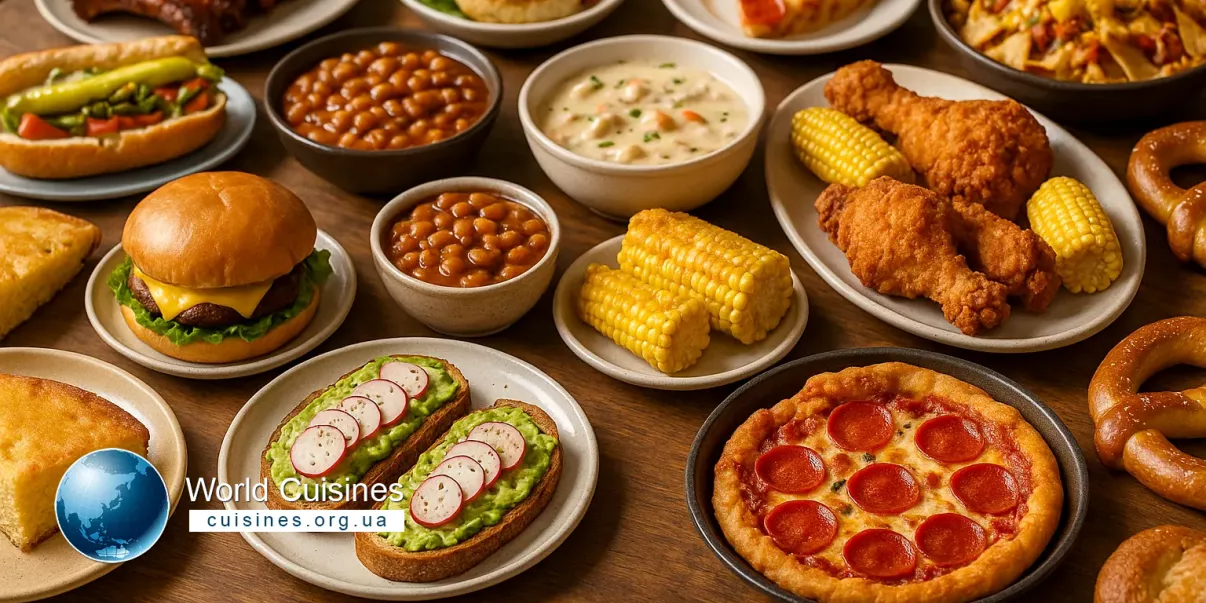
An abundant regional spread showcasing iconic dishes from across the United States – from Southern fried chicken and cornbread to New England clam chowder and West Coast avocado toast.
American cuisine cannot be reduced to a single narrative – it's a collection of local stories, regional innovations, and deeply rooted foodways that together form a national identity. From the smoked meats of Texas to the clam chowders of New England, every part of the United States contributes to a rich culinary landscape. The Northeast brings hearty dishes rooted in English and Irish traditions, while the South is known for deeply flavored comfort food shaped by African, French, and Caribbean influences. The Midwest offers a celebration of grains, dairy, and casseroles, reflecting its agricultural heartland. On the West Coast, fresh produce, seafood, and Asian-Pacific flavors define the plates, while the Southwest draws on Native American and Mexican heritage to deliver bold, spicy combinations. Immigration continues to shape the food culture of America, particularly in urban centers where entire neighborhoods offer immersive experiences in Vietnamese, Ethiopian, Salvadoran, or Korean cuisine. In this way, American cuisine becomes not a static set of recipes, but a living reflection of its people – complex, evolving, and deeply local.
Main Features and Ingredients
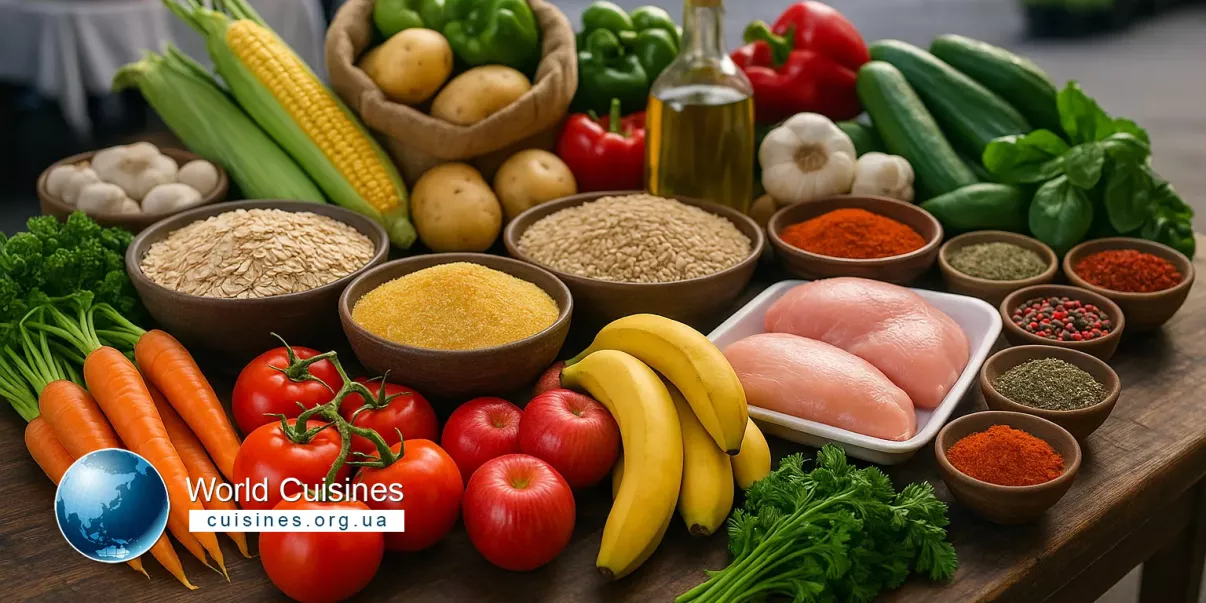
Fresh produce, grains, meats, and spices commonly found in American markets, representing the diversity of ingredients across different regions and climates.
The ingredients of American cuisine vary widely across regions, but several themes are consistent: an emphasis on seasonal produce, a blend of local and imported flavors, and a willingness to innovate. Corn, a staple since pre-Columbian times, appears in countless forms – from cornbread to grits. Potatoes, tomatoes, beans, and leafy greens are common in everyday cooking, while meats like beef, pork, and chicken serve as the centerpiece in many traditional meals. Dairy products play a prominent role in the Midwest and Northeast, while seafood dominates in coastal regions. The American South relies heavily on smoked and cured meats, collard greens, and legumes like black-eyed peas. In the Southwest, chili peppers, tortillas, avocados, and spices such as cumin and coriander feature prominently, reflecting Latin American influences. Another defining feature is the integration of international ingredients. Soy sauce, ginger, curry powder, harissa, and miso are no longer niche items but regular parts of the American pantry. This inclusivity allows American cuisine to be simultaneously traditional and experimental – equally at home with roast turkey and Korean tacos.
Popular Dishes of American Cuisine
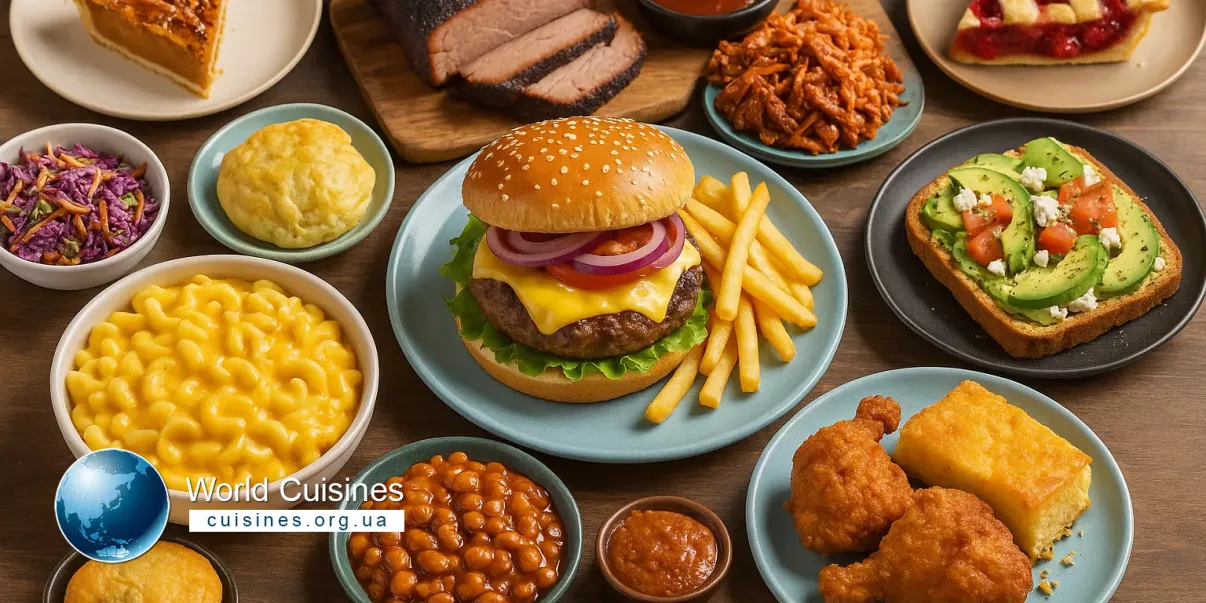
A colorful display of well-known American meals, including burgers, barbecue, mac and cheese, and traditional pies – each tied to a distinct regional or cultural background.
American cuisine has given the world many iconic dishes. The hamburger, born from German immigrant traditions and industrial innovation, is now a global symbol of American food culture. Fried chicken, with roots in both Scottish and West African cooking, has become a beloved staple across the country. Barbecue, ranging from Carolina-style pulled pork to Texas beef brisket, is celebrated as both craft and ritual. Macaroni and cheese, a comfort food classic, represents the American love of simple, hearty meals. Clam chowder, especially in New England, offers a taste of the coastal North, while gumbo and jambalaya showcase the Creole richness of Louisiana. Pancakes, meatloaf, chili, peanut butter sandwiches, and apple pie are all deeply familiar parts of American culinary life – each with its own story, regional twist, and emotional weight in family tradition.
Traditional American Recipes
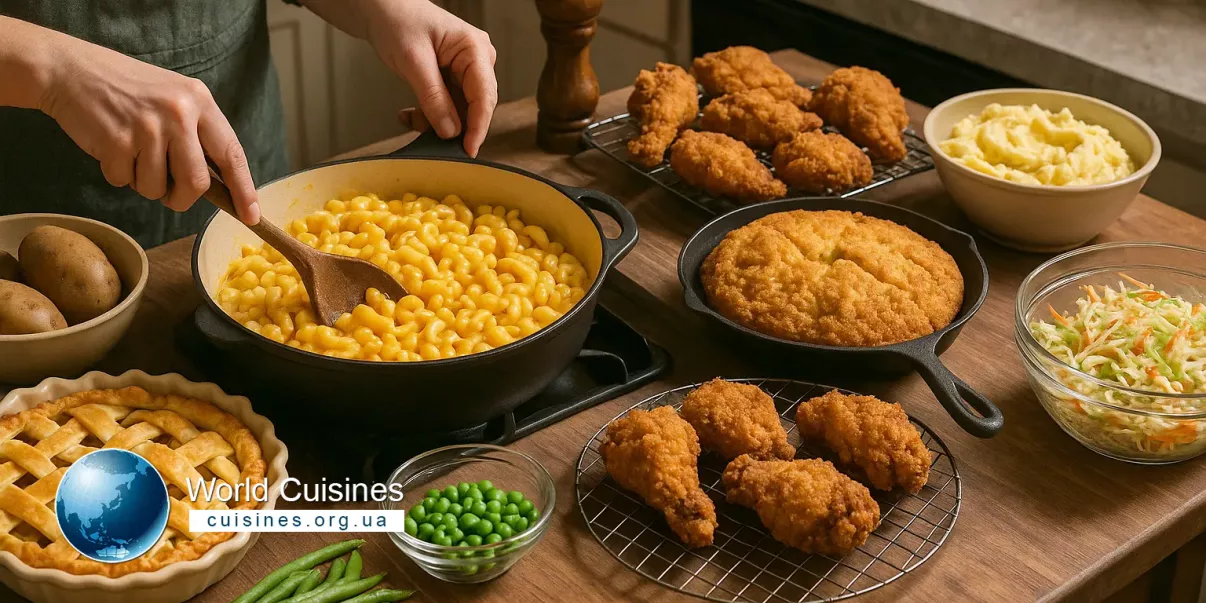
Comfort food classics being prepared in a home kitchen setting, reflecting family traditions, seasonal ingredients, and the warmth of everyday American cooking.
Traditional American recipes often balance practicality with flavor, drawing on local ingredients, immigrant knowledge, and domestic creativity. In the rural South, cornbread baked in cast-iron skillets accompanies dishes like collard greens or stewed beans. The Midwest’s casseroles and pot pies reflect both frugality and comfort, designed to feed large families with hearty ingredients. In New England, seafood stews and chowders make the most of coastal abundance, while recipes like succotash or baked beans reach back to Indigenous food traditions. At the heart of many homes are recipes passed down through generations – banana bread from a grandmother’s kitchen, barbecue rubs guarded like family secrets, or holiday stuffing made just once a year. These recipes are more than instructions; they are rituals that preserve identity, carry memory, and bring people together through shared taste.
Typical Spices and Flavors
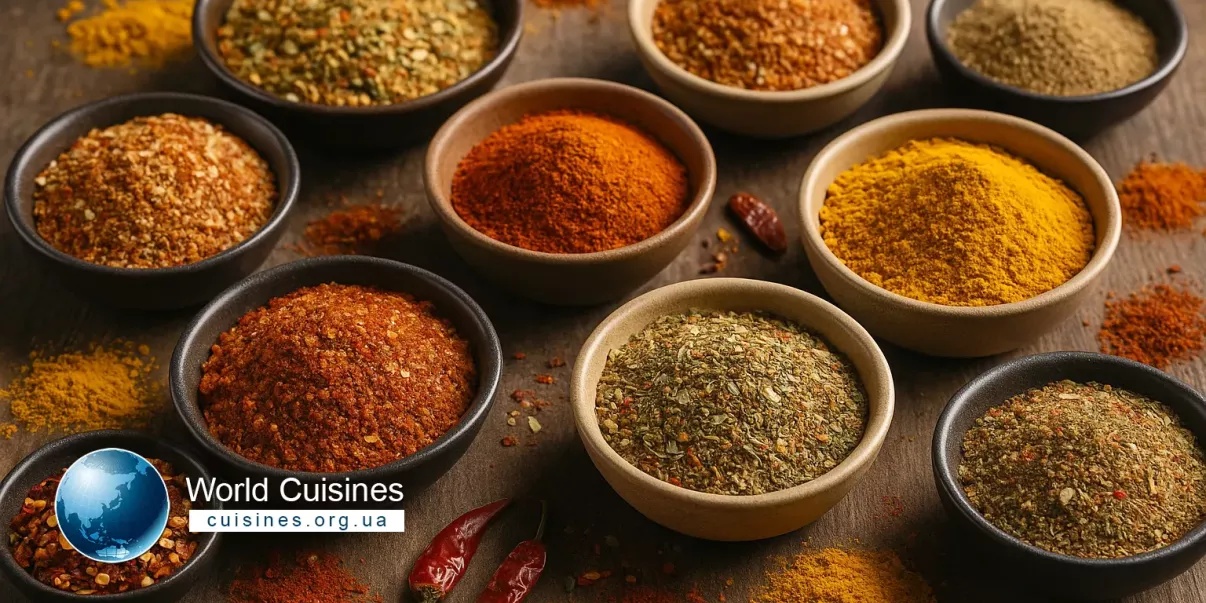
An assortment of spices, seasoning blends, and dry rubs used in American cuisine – from bold Southern mixes to herb-forward coastal combinations.
Spicing in American cuisine is highly regional. The South is known for bold seasoning – smoked paprika, cayenne, garlic powder, and complex spice rubs for grilling and frying. Cajun and Creole cooking uses blends with oregano, thyme, black pepper, and chili heat. In the Southwest, cumin, chili powder, and lime are essential, often combined in marinades and sauces. Elsewhere, flavors are more restrained. New England dishes favor herbs like sage, bay leaf, and parsley, especially in broths and roasts. In California and the Pacific Northwest, fresh herbs, citrus zest, and light vinaigrettes dominate, reflecting a health-conscious approach. Sweet-and-savory combinations, like maple-glazed bacon or honey barbecue, also define much of the flavor landscape. American cuisine embraces spice as a tool for contrast and personality rather than dominance. Whether subtle or bold, the seasoning always reflects the character of the dish and the culture behind it.
Influence and Global Spread
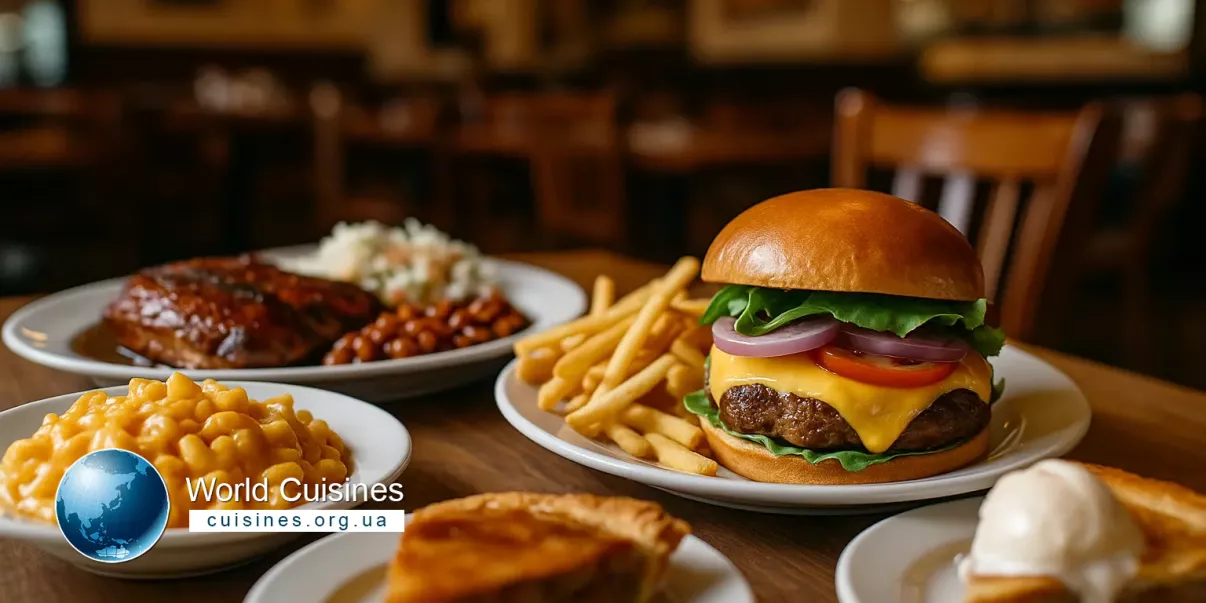
American-style dishes served in international restaurants, highlighting the global reach and cultural impact of American food traditions around the world.
American cuisine has had an outsized impact on global food culture. Fast food chains, barbecue joints, diners, and coffee shops bearing American styles can be found across continents. Burgers, fries, fried chicken, and milkshakes are now international staples – not only due to marketing, but because of their universal appeal. Yet American culinary influence is not limited to fast food. Techniques such as dry-rubbing, smoking, brunch menus, and comfort-style plating have been widely adopted by chefs worldwide. The global food scene increasingly draws inspiration from American reinvention – mixing authenticity with accessibility, honoring roots while creating something new. This culinary export is two-way: as American chefs look outward for inspiration, they continue to reinterpret and expand what American cuisine can be.
Detailed Questions and Answers About American Cuisine
The hamburger is often considered the most iconic American dish because of its widespread popularity, simplicity, and adaptability. Served with fries and a soft drink, it represents the fast-food culture that originated in the United States and spread globally, while also being reinterpreted in countless gourmet versions.
Immigration has profoundly shaped American cuisine by introducing new ingredients, flavors, and cooking methods. Italian immigrants brought pizza and pasta, while Chinese communities popularized stir-fry and takeout culture. Mexican, Middle Eastern, Caribbean, and Indian cuisines have also influenced American food, creating a dynamic and evolving culinary landscape.
American cuisine is a broad term, but regional cuisines highlight specific traditions tied to geography and culture. For example, Southern cuisine is known for fried chicken, grits, and collard greens, while New England specializes in clam chowder and lobster rolls. Tex-Mex in the Southwest and Pacific fusion in California show how local influences shape distinctive food identities.
Traditional American breakfasts often include eggs, bacon, pancakes, waffles, oatmeal, or cereal, served with coffee or juice. In diners and homes across the country, hearty combinations like scrambled eggs with toast, sausage, and hash browns are popular, while regional favorites include biscuits with gravy in the South and bagels with cream cheese in New York.
Barbecue holds a special place in American food culture because it reflects community traditions, regional pride, and slow-cooked craftsmanship. Different regions have distinct barbecue styles, from smoky brisket in Texas to pulled pork in the Carolinas. Barbecue gatherings are also a social event, bringing people together for holidays, sports, and celebrations.
American desserts are diverse and indulgent, with classics such as apple pie, brownies, chocolate chip cookies, cheesecake, and pumpkin pie. Each dessert often carries regional or seasonal significance, like pecan pie in the South or key lime pie in Florida, making sweets an important part of American food identity.